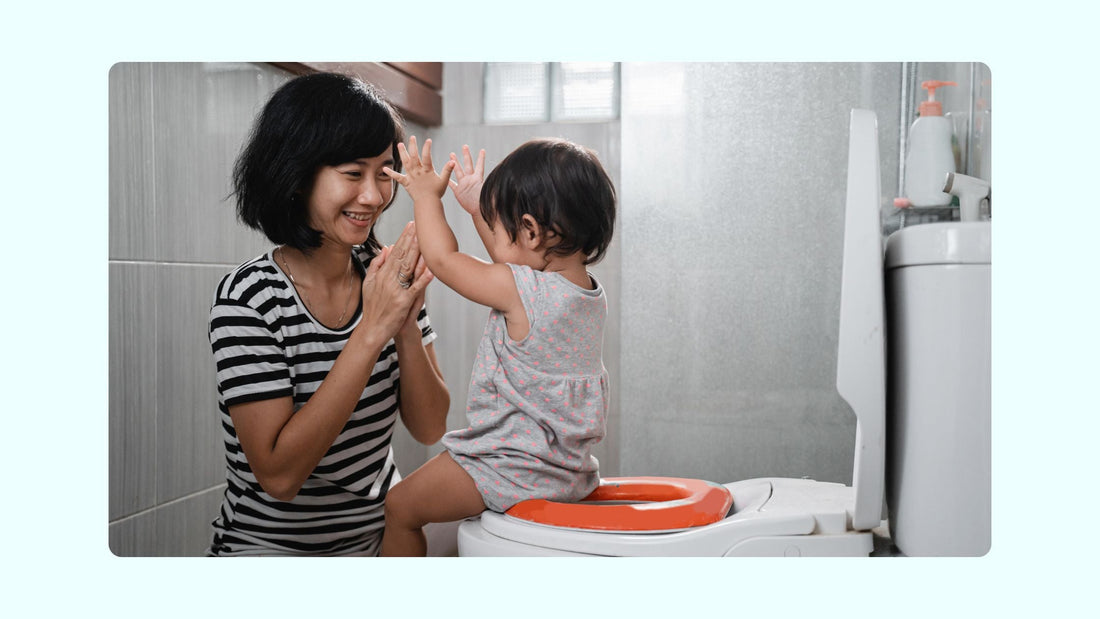
Elimination Communication Explained: Signals, Timing, & Tips for Parents
Share
Elimination communication, often called EC, is a gentle practice where parents tune in to their baby’s natural cues around peeing and pooping. Instead of assuming every need will be met with a diaper, EC encourages offering the potty when you notice signs that your baby is about to go.
Some families begin elimination communication from birth, while others try it around 6 months or later, when daily rhythms are easier to recognize.
EC is a common practice in many parts of the world, but has only recently started gaining traction in Western countries.
Elimination Communication vs Potty Training
While both EC and potty training involve helping children use the toilet, they differ in timing and approach:
-
Elimination communication: Begins in infancy, often from birth or within the first six months. Parents respond to signals, using diapers as a backup when needed.
- Potty training: Usually begins between 18 months and 3 years, after full-time diaper use. The focus is on unlearning diaper habits and building independence.
EC is more natural-minded — it reduces the need for diapers, lowers costs, and cuts down on skin contact with chemicals. Potty training, on the other hand, is about transitioning later in life.
Both are valid approaches. What matters most is what works best for your family.
When to Start Elimination Communication
Elimination Communication From Birth

Parents who start elimination communication from birth often describe it as surprisingly intuitive. Newborns naturally resist soiling themselves, and many signal their needs through squirming or sudden fussing. Offering a potty in these moments can cut down on blowouts and keep baby’s skin cleaner and healthier — something that may be especially valuable if your baby has eczema or is prone to diaper rash.
Starting early doesn’t mean you need to go completely diaper-free — even catching one or two potties a day helps you and your baby build communication while reducing reliance on diapers. Many parents keep a diaper on their baby as backup.
RELATED: Elimination Communication Tips from a Mama Who's Mastered It
Elimination Communication at 6 Months & Up

For families who wait until baby is a little older, elimination communication at 6 to 18 months can be just as effective. Babies at this stage often fall into clearer patterns — like going after naps or meals — making it easier for parents to offer the potty.
Using EC part-time can still offer meaningful benefits. Fewer diaper changes can save money, while giving baby’s skin a break from constant exposure to moisture and chemicals. With less irritation and fewer rashes, many parents find EC helps them simplify their skin care routine, too.
Elimination Communication Signals
Babies often show signs before they need to go. Common elimination communication signals include:
- Fussing, squirming, or going still suddenly
- Grunting or straining
- Pulling at the diaper
- Waking up with urgency
- Peeing right after nursing or naps
Recognizing these cues can help you catch more in the potty.
Caring for Baby’s Skin During Elimination Communication

Even when practicing elimination communication, babies still need gentle care after using the toilet. Because their skin is thinner and more delicate than an adult’s, the products and materials you use matter.
-
Toilet paper can be too rough: It may cause microtears or irritation, especially with frequent wiping.
-
Wet wipes can disrupt the skin barrier: Many contain preservatives or harsh cleansers that strip away protective oils, leaving baby’s skin vulnerable to rashes or eczema flare-ups. Plastic in many wipes is also irritating.
A gentler solution is a cleansing cream. Unlike wipes or dry paper, a cream-based cleanser both removes waste and nourishes the skin, leaving behind a light protective barrier. That’s why NOLEO 3-in-1 Diaper Care works so well during EC — it cleans, moisturizes, and shields baby’s skin in one simple step. And if you slip a diaper on your baby afterward, the barrier layer helps protect against moisture and irritation.
EC Encouragement for Parents
At NOLEO, we believe elimination communication is a wonderful tool if it works for you. Remember, it doesn’t have to be all-or-nothing. Some parents use EC part-time; others find it becomes a daily rhythm.
If you choose to use it, EC is a natural way to connect with your baby, simplify diaper care, and give their skin a healthy start.
